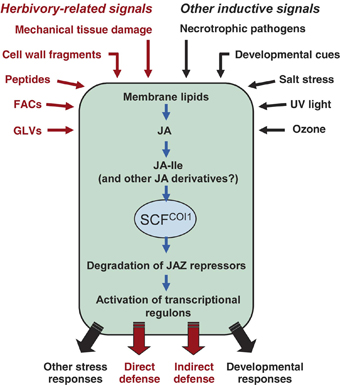Research: Project 1
Molecular Mechanism of Jasmonate Signaling
Herbivorous insects use diverse feeding strategies to obtain nutrients from their host plants. Rather than acting as passive victims in these interactions, plants cope with herbivory through the production of myriad specialized metabolites and proteins that exert toxic or anti-feedant affects on herbivores, or volatile substances that act indirectly by attracting predators of the herbivore. This highly dynamic form of immunity is initiated by the recognition of insect oral secretions and signals from injured plant cells. The plant hormone jasmonate (JA) plays a conserved and central role in this process by regulating genome-wide changes in gene expression.
A long-term objective of our research is to elucidate the molecular mechanism by which JA controls gene expression. A combination of genetic, cell biological, molecular, and biochemical analyses indicates that the core signal transduction chain linking JA synthesis to hormone-induced changes in gene expression consists of four components: a bioactive JA signal, the SCF-type E3 ubiquitin ligase SCFCOI1, JAsmonate ZIM-domain (JAZ) repressor proteins that are targeted by SCFCOI1 for degradation via the ubiquitin/26S proteasome pathway, and transcription factors (TFs) that promote the expression of JA-responsive genes (Fig. 1). Recent studies from our lab indicate that the F-box protein COI1 is a critical component of the JA receptor, and that jasmonoyl-isoleucine (JA-Ile), an amino acid-conjugated form of JA, is a natural ligand for this receptor system. A major unanswered question we seek to address is how the specificity of receptor-ligand and JAZ-TF interactions regulates the diversity of JA-mediated responses.
